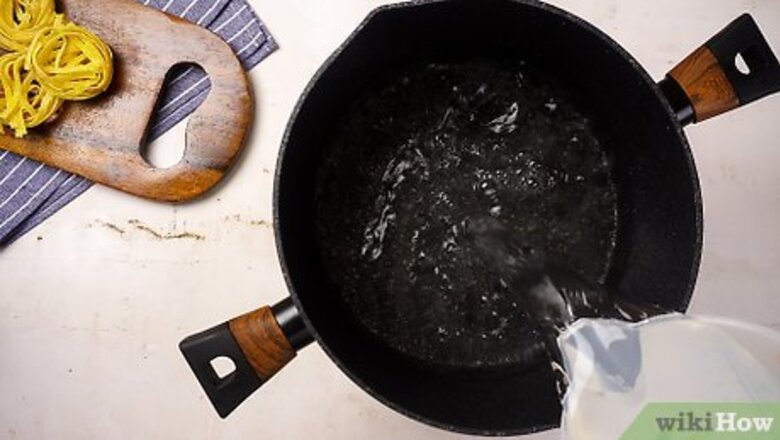
views
Stovetop
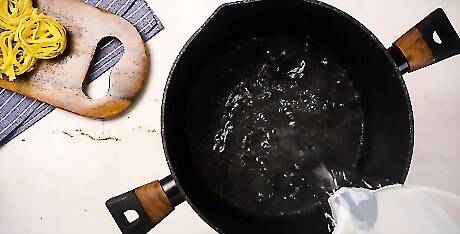
Pour at least 4 US quarts (3.8 L) of water into a large pot. If you're cooking a 16-ounce (454 g) box of dried tagliatelle, set a large pot on the stove and pour in 4 US quarts (3.8 L) of water. All this water gives the noodles room to expand as they cook. If you're not cooking an entire box of tagliatelle, you can use less water. Plan on using 1 US quart (0.95 L) of water for every 4 ounces (113 g) of pasta.
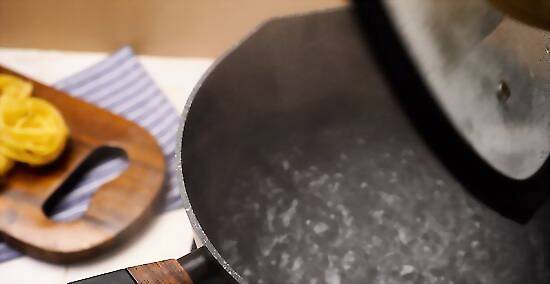
Put the lid on the pot and bring the water to a boil. Covering the pot makes the water boil faster. Turn the burner to high and watch for steam escaping from under the sides of the lid. Bring the water to a vigorous rolling boil so your tagliatelle starts cooking as soon as you add it to the pot. Don't add salt yet, since boiling salt water can damage the surface of your pot.
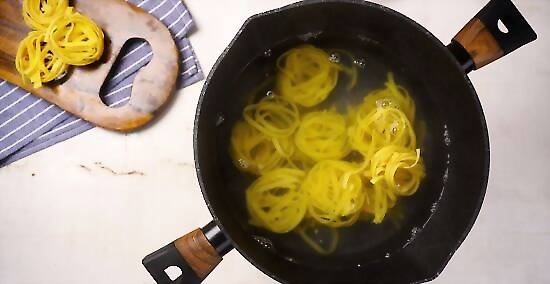
Add 1 tbsp (17 g) of salt and 1 pound (454 g) of dried tagliatelle to the pot. Wear oven mitts to remove the lid from the pot. Then, pour in 1 tablespoon (17 g) of salt and 1 pound (454 g) of dried tagliatelle. Stir the noodles immediately so they don't clump together. You can use long tagliatelle noodles or dried tagliatelle nests. The cooking process doesn't change for the nests, since they'll unravel and cook similar to the long noodles.

Boil the uncovered tagliatelle for 8 to 10 minutes. Set a timer for 8 to 10 minutes and stir the pasta occasionally as it boils. After 8 minutes, use a pasta fork to remove a noodle and bite into it. Turn off the burner if it's as tender as you like. If not, cook the tagliatelle for up to 2 more minutes.

Reduce the cooking time to 3 to 5 minutes if you're using fresh noodles. If you've made homemade tagliatelle or bought refrigerated pasta, you don't need to boil the noodles as long. Start checking the noodles after 3 minutes to see if they're tender.
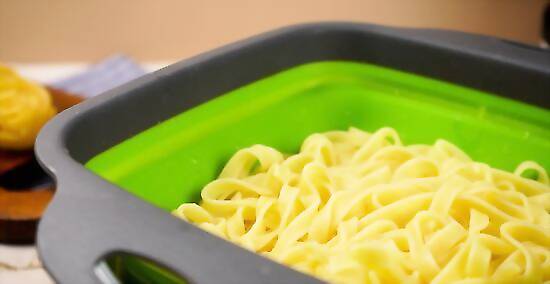
Set a colander in the sink and drain the tagliatelle. Wear oven mitts to protect your hands as you drain the noodles. Carefully pick up the pot of pasta and slowly pour the tagliatelle into the colander. Then, you can serve the noodles with sauce or store them for later. Refrigerate the tagliatelle in an airtight container for up to 5 days.
Microwave
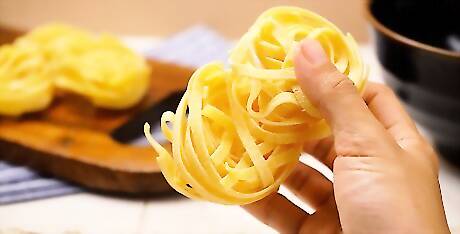
Measure 2 oz (56 g) of dry tagliatelle for 1 serving of pasta. To easily measure the pasta, gather enough dried noodles in your hand to make a bunch that's the diameter of a quarter. This 2 oz (56 g) amount of dry tagliatelle makes 1 cup (125 g) of cooked pasta. If your package of tagliatelle comes in nests instead of long noodles, use 2 nests.
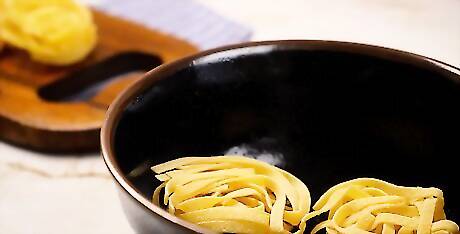
Break the tagliatelle in half and put it into a microwave-safe bowl. Break the long pasta noodles in half so they fit into a large microwave-safe bowl. Choose a bowl that's large enough for the pasta to double or triple in size. You may need to break the noodles into thirds if you're having trouble getting them to fit in the bowl. If you're using nests, skip this step.

Pour in enough water to cover the pasta by 2 inches (5.1 cm). Pour in cold or room-temperature tap water so the noodles are completely submerged. Keep adding water until it covers the tagliatelle by 2 inches (5.1 cm) since the pasta expands as it cooks. If you use hot or boiling water to start with, your noodles might become gummy.
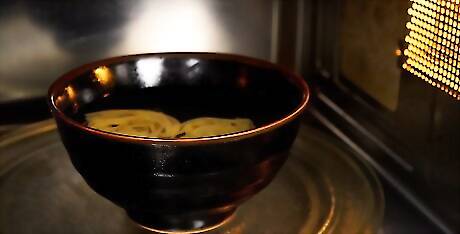
Microwave the noodles on "High" for 3 minutes longer than the package instructions. Read the cooking time on the package and add 3 minutes. Then, place the bowl of pasta in the microwave and heat it on "High" for that amount of time. Keep the bowl uncovered to allow steam to escape and stop the microwave if you see the tagliatelle boil over. For example, if the package says to boil the noodles for 7 minutes, microwave them for 10 minutes.
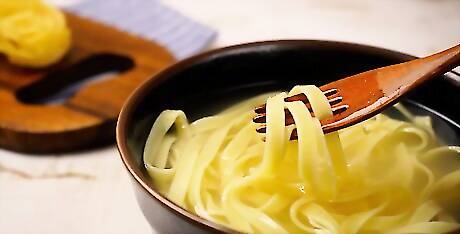
Bite into a noodle to test if the pasta is finished. Wear oven mitts to take the bowl out of the microwave and carefully pull a noodle out of the pot using a pasta fork. Let it cool until you can comfortably bite into it to see if it's as cooked as you like. If the noodles aren't soft enough, put the bowl back in the microwave and heat it for 30 seconds before you check it again.

Drain the tagliatelle and use the noodles while they're hot. If you think the pasta is done, set a colander in the sink and pour the pasta into it. Shake the colander a little so all of the water drains into the sink. Then, transfer the pasta to a serving plate and coat it with your favorite sauce. If you have leftover noodles, store them in the fridge in an airtight container for up to 5 days.
Serving Ideas

Spoon meaty ragu sauce over tagliatelle for a classic Italian meal. Build a flavorful meat sauce by simmering onions, celery, and carrots with beef, pancetta, and red wine for a few hours. Then, toss a batch of cooked and drained tagliatelle with the ragu sauce and serve it with a bold red wine. If you'd like to try a vegetarian version, leave out the beef, pancetta, and beef broth. You can use cooked lentils and sautéed mushrooms in place of the meat
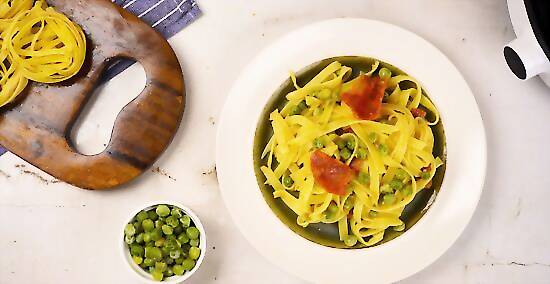
Cook peas with the tagliatelle and add prosciutto for a light, spring dish. Add 1 ⁄2 pounds (680 g) of frozen peas to the pasta about 2 minutes before the tagliatelle finishes boiling. Once the pasta is tender, save some of the cooking water before you drain the noodles. Then, toss the pasta and peas with pan-fried prosciutto, Parmesan, and the reserved cooking water. For a little citrus flavor, mix in the zest of a lemon. The cooking water creates a flavorful sauce that coats the noodles.
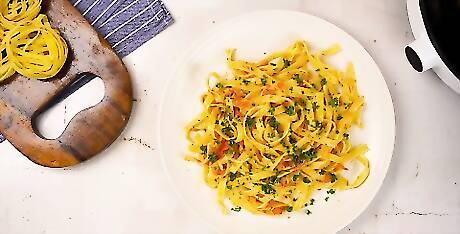
Make a quick garlic and tomato sauce for a vegetarian tagliatelle meal. While your tagliatelle is cooking, heat thinly sliced garlic in olive oil. Once you can smell the garlic, add chopped tomatoes with a pinch of crushed red pepper flakes and salt. Let this sauce simmer for about 20 minutes before you mix it with the drained pasta. Keep about ⁄2 cup (120 ml) of the pasta cooking liquid so you can thin the tomato sauce if it's too thick.
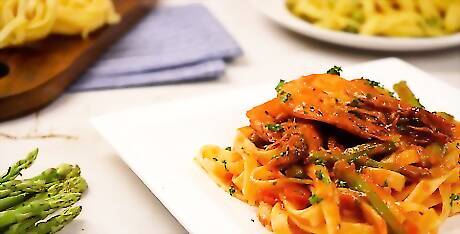
Create a seafood tagliatelle dish with shrimp and asparagus. Sauté 1 pound (450 g) of shrimp until it turns pink and satué asparagus pieces in a separate skillet until they're tender. Toss cooked and drained tagliatelle with the shrimp and asparagus. Then, season the dish with your choice of sauce. Try alfredo sauce for a creamy meal or drizzle some fresh pesto over the noodles for a bright, herb flavor. You could also make a fragrant coconut and shallot sauce to mix with the tagliatelle.



















Comments
0 comment